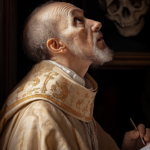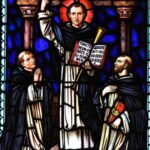St. Martha
St. Martha
When they lived:
St. Martha, believed to have been born around the 1st century AD, lived during the time of early Christianity in the Roman province of Judea.
Where they lived:
St. Martha resided in the village of Bethany, a short distance from Jerusalem. This quaint village, nestled on the eastern slope of the Mount of Olives, provided the backdrop for many of the significant events in her life.
Notable world events during the time of their life:
- Construction of the Roman Colosseum (70-80 AD): As St. Martha lived through the first century, she would have been aware of the grand construction of the Roman Colosseum, an iconic amphitheater in Rome, showcasing the might of the Roman Empire through gladiatorial contests and other spectacles.
- Boudicca’s Revolt (60-61 AD): Martha might have heard tales of the fierce warrior queen Boudicca leading an uprising against Roman rule in Britain, highlighting the ongoing conflicts within the expanding Roman Empire.
- Great Fire of Rome (64 AD): The infamous fire that swept through Rome during the reign of Emperor Nero would have been a topic of discussion even in far-off Bethany, emphasizing the interconnectedness of the Roman world.
- Pompeii and Herculaneum Destruction (79 AD): While not directly impacting St. Martha’s region, the eruption of Mount Vesuvius and the subsequent destruction of Pompeii and Herculaneum brought attention to the raw power of nature.
- Spread of Buddhism: In the East, Buddhism continued to spread during St. Martha’s lifetime, highlighting the diverse spiritual landscape of the ancient world.
- Emergence of the Silk Road: The trading network known as the Silk Road was growing in significance, linking the East and West and facilitating the exchange of goods, ideas, and cultures.
Their patronage:
St. Martha is widely recognized as the patron saint of homemakers, cooks, and innkeepers. Her hospitality and devotion to serving Jesus and his disciples exemplify her role as a patron for those who embrace the responsibilities of domestic life. Her story reminds us of the importance of welcoming others with an open heart and finding spiritual meaning in everyday tasks.
Martha’s encounter with Jesus, as recounted in the Bible, demonstrates the balance between active service and contemplative devotion. Her willingness to serve in practical ways while also engaging in deep theological conversations with Jesus makes her an intriguing figure for people seeking to integrate their faith into their daily lives.
In an age where the balance between material and spiritual pursuits is often challenged, St. Martha’s example offers guidance on finding harmony between hospitality, faith, and personal growth. Whether in the bustling kitchens of modern households or the quiet corners of meditation, St. Martha’s legacy continues to inspire individuals to find the divine in the ordinary and to extend warmth and kindness to all who cross their paths.
Martha, the Anxious Server
Nothing was recorded about the early life of St. Martha. Thankfully, we could see a glimpse of her life through the Gospels. What is clear about Martha is that she was from Bethany, a small village about two miles from Jerusalem. She had two siblings, Mary and Lazarus. It was evident that Jesus was a close friend to them.
Martha was mentioned in three Gospel passages. These passages show the type of friendship these siblings had with the Lord Jesus. The first instance, in the Gospel according to Luke (10:38-42), we could find how Martha received Jesus in their home. She was described as a very busy guest master, worrying herself with serving Jesus. While she was frantically preparing something for Jesus, her sister Mary sat beside the Lord’s feet and listened to Him speaking, without being bothered by her sister’s business. Martha was worrying so much about the work, she did not have time to enjoy being with Him and listening to His words. Martha complained about how her sister was not helping her serve. Jesus replied to her, saying, “Martha, Martha, you are anxious and worried about many things. There is a need for only one thing. Mary has chosen the better part and it will not be taken from her.” (Luke 10:41-42). Jesus had put Martha’s over-worrying into the right context who emphasized the importance of contemplating Him before all things.
Martha’s Faith
The second instance, in the Gospel according to John (11:1-44), we could find Martha and her sister Mary mourning the death of their brother Lazarus. He had died for four days when Jesus went to Bethany. She told the Lord that if He was there with them earlier, their brother would have not died. But Jesus gave her a revelation: “I am the resurrection and the life; whoever believes in me, even if he dies, will live, and everyone who lives and believes in me will never die. Do you believe this?” to which Martha replied, “Yes, Lord. I have come to believe that you are the Messiah, the Son of God, the one who is coming into the world.” (John 11:25-27). Moved by this kind of faith, Jesus went to Lazarus’ tomb and ordered that it be opened. Martha’s faith was confirmed by Jesus through raising Lazarus back to life.
Martha’s “New” Serving
The third and last instance, again in the Gospel according to John (12:1-2), six days before the Passover, we could find Jesus in the house of the three siblings. They hosted Him for dinner, probably a thanksgiving celebration for such a miracle of raising Lazarus from the dead. Once again, we could see in these passages that Martha was serving again. But this time, her serving was different from the first. Her serving was infused with her faith and peace.
Early traditions say that after the first persecutions of Christians, Martha, Mary and Lazarus and other disciples left their own land and went to France, arriving in Saintes-Maries-de-la-Mer, in Provence, where they brought the Christian faith. In Bethany, now called El-Azariyeh or “the place of Lazarus”, we can find the tomb of Lazarus and a sanctuary built upon the ruins of Byzantine and Crusader structures. This is believed to be the house of Martha. Her feast day is celebrated on July 29.
Five Interesting Facts About St. Martha
- St. Martha is the patron saint of housewives, servants, waiters and cooks.
- St. Martha is commonly regarded as typifying the active Christian life as contrasted with her sister Mary, who typifies the contemplative life.
- The name “Martha” in Aramaic means “lady or mistress of the house”.
- St. Martha is also venerated in the Eastern Christianity, Anglican Communion and Lutheran Church.
- St. Martha is depicted in Christian art with a dragon trampled by her feet, which merited her the nickname “the dragon slayer”! This was according to a legend about her, who fought, caught and tied up a “dragon” (probably a crocodile) that killed many people.
Prayer to St. Martha
O God, whose Son called Lazarus to life from the grave.and was pleased to be welcomed in Martha’s house as a guest, grant, we pray, that, serving faithfully our brother and sisters, we may merit, with Mary, to be fed by meditating on your words.Through our Lord Jesus Christ, your Son, who lives and reigns with you in the unity of the Holy Spirit, one God, for ever and ever. Amen.



